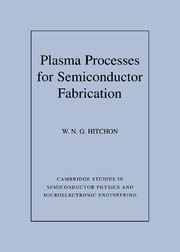Book contents
2 - Plasma Processes for Semiconductors
Published online by Cambridge University Press: 01 October 2009
Summary
The plasmas used in processing semiconductors are usually partially ionized gases, the neutral gas pressure being from about 1 mTorr to about 100 mTorr and the plasma (that is, the charged particle) number density n being in the range 1010 cm−3 ≲ n ≲ 1012 cm−3. To describe these plasmas precisely and in detail is difficult for a number of reasons. Plasma physics textbooks are largely devoted to detailed analysis of the special cases that can be described by analytic theories. Instead, it is often more useful to try to obtain approximate descriptions of the real plasma using simple physical reasoning.
In trying to understand a complex physical system it is usually useful to try several different approaches, such as studying different physical pictures, and to attempt to reconcile them with available data. In this book we will attempt to describe each situation we consider starting from “first principles” in each case. A major theme throughout will be the development of approximate quantitative models to explain experiments, based on simple reasoning. Statistical design and analysis of experiments, for example [5], provides a valuable tool for building up physical understanding.
It is tempting to say that theoretical models of processing plasmas are like houses made of cards. After a few layers (of assumptions) the whole edifice is in danger of collapsing.
- Type
- Chapter
- Information
- Plasma Processes for Semiconductor Fabrication , pp. 8 - 30Publisher: Cambridge University PressPrint publication year: 1999



